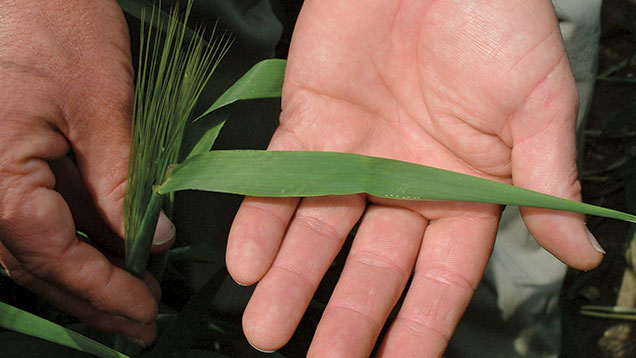T2 fungicide advice for high barley yields

The T2 spray is more important in hybrid winter barley than conventional barley varieties due to the size of its flag leaf, claims Iain Anderson of Syngenta.
“Normally in barley, the successive leaves diminish in size,” he says. “So fungicide programmes have tended to reflect this plant architecture, with the T2 spray being slightly less important that the T1.
See also: How to get your T2 timing right to maximise wheat yields
“As a result, the traditional advice has been to put less fungicide on at flag leaf – cutting back by about 20% compared to T1.”
That approach should be re-considered where hybrids are being grown, he advises. “They are different to other six-rows and the two-rows. They have a great big flag leaf which makes a significant contribution to yield.”
Mr Anderson refers to Syngenta trials conducted over the last two years, which showed that there was more of a yield penalty from missing out the T2 spray than the T1 treatment on Hyvido varieties.
“There wasn’t a great deal of disease in 2013, but the 2014 work showed a very clear response.”
Protecting the big flag leaf means applying the T2 fungicide at awn emergence, otherwise known as the paintbrush stage, he recommends.
“Often, this spray is driven by the PGR timing, which is a bit of a compromise. The PGR needs to be on before ear emergence, but the fungicide should go on later than that. The hybrids do respond to careful timings.”
Iain Anderson, Syngenta
“Often, this spray is driven by the PGR timing, which is a bit of a compromise. The PGR needs to be on before ear emergence, but the fungicide should go on later than that. The hybrids do respond to careful timings.”
He advises the use of an SDHI/triazole/chlorothalonil mix at T2.
“Good results were achieved last year with a Cebara/Proline/Bravo mix. The triazole was added in due to the high disease pressure – it will depend on the season whether it’s required again.”
The Bravo is required for ramularia control at T2, he adds.
Mr Anderson’s guidance on rates is to keep them up.
“Our recommendation is to use 1.6 litres/ha of Cebara and 1 litre/ha of Bravo. If you are adding in Proline as well, then you need a minimum of 1 litre/ha of Cebara and 0.3 litres/ha of Proline.”
His final point is that the T2 spray has both a yield contribution and a grain quality benefit. “You do get specific weight improvements with the T2 application, so it’s an important timing for that reason too.”

